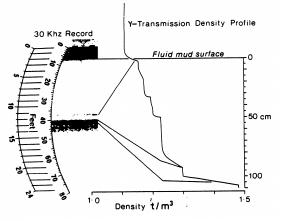In situ measurement of wet bulk density
This article is a summary of chapter 9 of the Manual Sediment Transport Measurements in Rivers, Estuaries and Coastal Seas[1]. This article describes how the the mass of the water-sediment mixture per unit volume (wet bulk density) can be measured in situ by mechanical, acoustic or nuclear radiation sensors.
Contents
Introduction
In deposition and navigation depth studies of muddy areas the wet (bulk) density defined as the mass of the water-sediment mixture per unit volume is an important parameter.
The position of the surface of consolidated mud layers can be determined by means of echo-sounding instruments. Good penetration can be obtained with 30 kHz-instruments (see Figure 1). Higher frequencies (210 KHz) do not have sufficient energy to penetrate into the bed.
Various methods are available to determine the wet bulk density: mechanical core sampler, acoustic probe, nuclear radiation probe, electric conductivity probe, vibration transducer probe, and pressure transducer probe. Electric conductivity probes and pressure transducer probes are not generally applicable. Electric conductivity probes are very sensitive to the fluid salinity which should be known beforehand. Pressure and vibration transducer probes can only be used in unconsolidated fluid muds (low density < 1200 kg/m3).
Sampling methods
Mechanical core sampler
A basic requirement is undisturbed sampling of bed material. Various mechanical core-samplers are available to take undisturbed bed material samples of the surface layers (upper 0.5 m of the bed). Most samplers can only be used during low velocity conditions to ensure vertical penetration of the bed.
After sampling, it is common practice to make slices by a machined ring of the same internal diameter as the core. The core content is extruded into the ring until it is full of the water-sediment mixture. A thin plate is then introduced between the ring and the core to isolate the sample.
As the core diameter is known and fixed and the slice thickness is fixed by the ring, the volume can be calculated. After weighing (and drying) of the sample, the wet and dry density can be determined.
Acoustic sensor
The principle of acoustic senors is based on measuring the attenuation of the intensity of monochromatic ultra-sonic waves through the (fluid) mud layer. See also General principles of optical and acoustical instruments.
Nuclear radiation sensor
The principle of a Nuclear radiation sensor is based on measuring the attenuation or scattering of the radiation intensity through a water-sediment mixture.
See also
Summaries of the manual
- Manual Sediment Transport Measurements in Rivers, Estuaries and Coastal Seas
- Chapter 1: Introduction, problems and approaches in sediment transport measurements
- Chapter 2: Definitions, processes and models in morphology
- Chapter 3: Principles, statistics and errors of measuring sediment transport
- Chapter 4: Computation of sediment transport and presentation of results
- Chapter 5: Measuring instruments for sediment transport
- Chapter 6: Measuring instruments for particle size and fall velocity
- Chapter 7: Measuring instruments for bed material sampling
- Chapter 8: Laboratory and in situ analysis of samples
- Chapter 10: Instruments for bed level detection
- Chapter 11: Argus video
- Chapter 12: Measuring instruments for fluid velocity, pressure and wave height
Other internal links
- Instruments and sensors to measure environmental parameters
- Acoustic point sensors (ASTM, UHCM, ADV)
- Acoustic backscatter profiling sensors (ABS)
- pump samplers
- Bottle and trap samplers
References
- ↑ Rijn, L. C. van (1986). Manual sediment transport measurements. Delft, The Netherlands: Delft Hydraulics Laboratory
Please note that others may also have edited the contents of this article.
|
Please note that others may also have edited the contents of this article.
|
